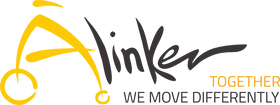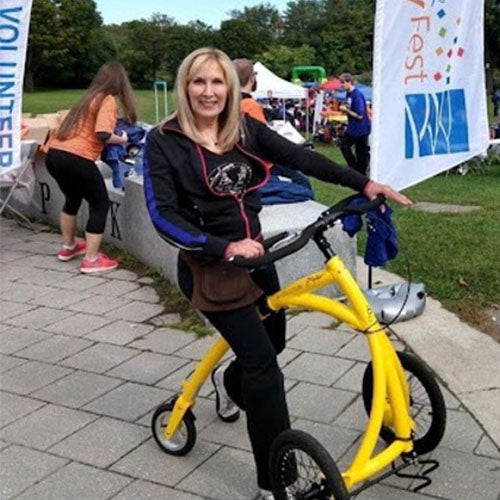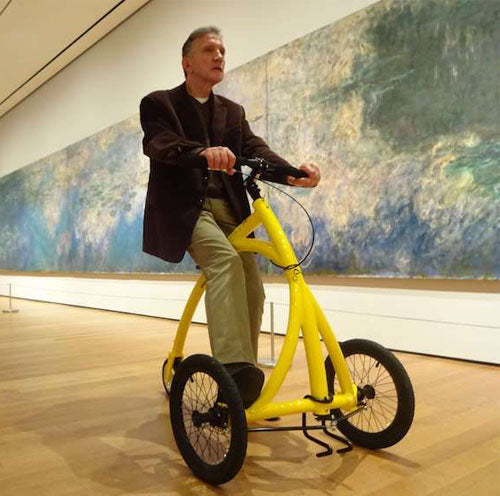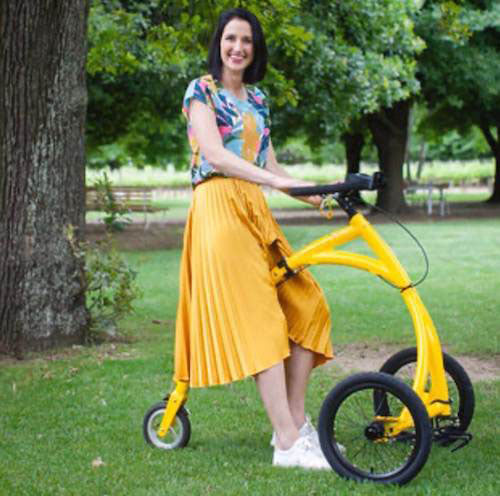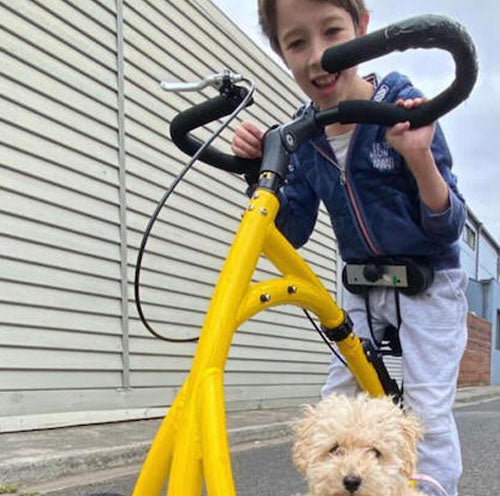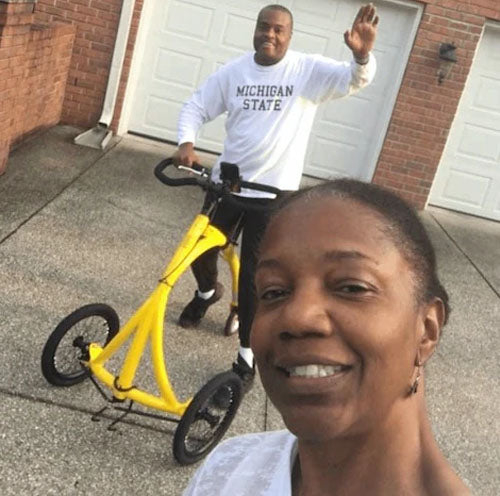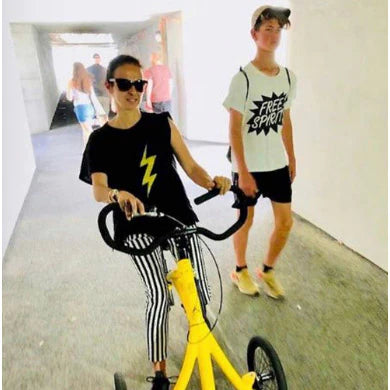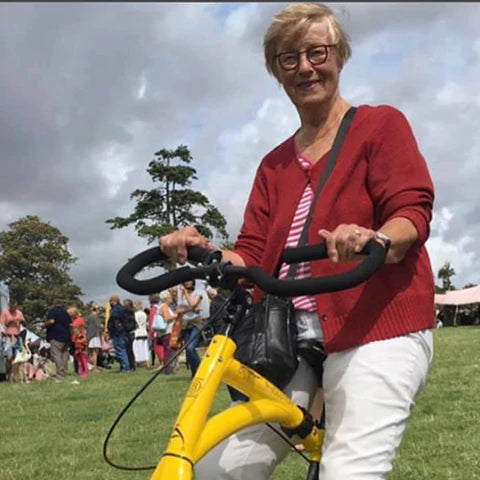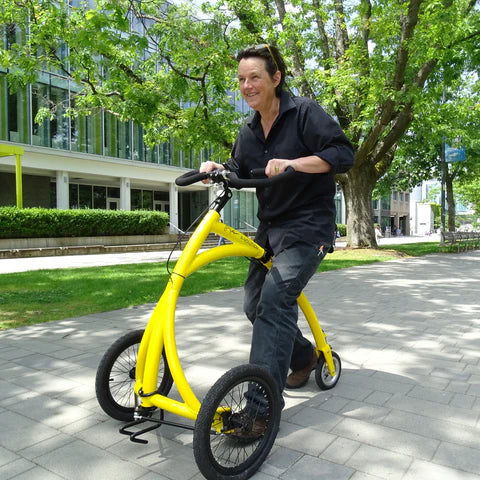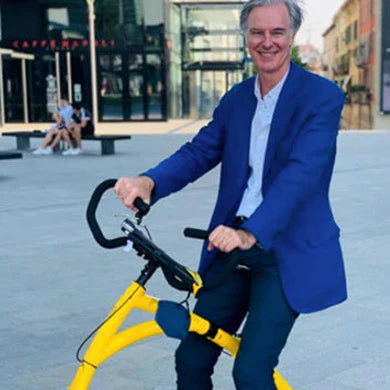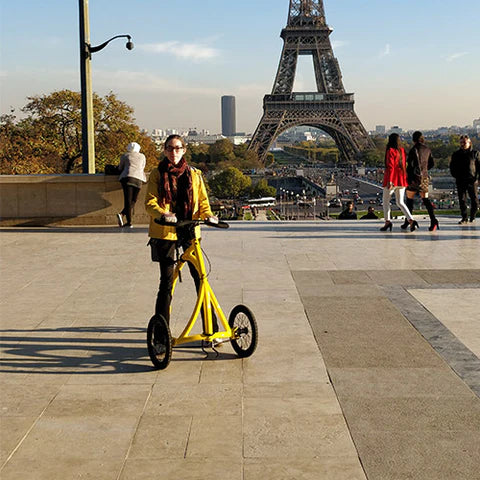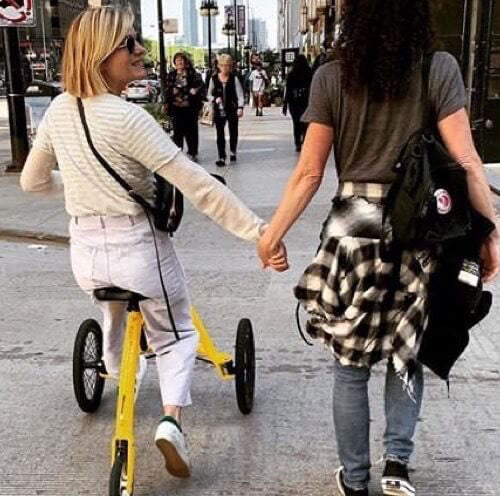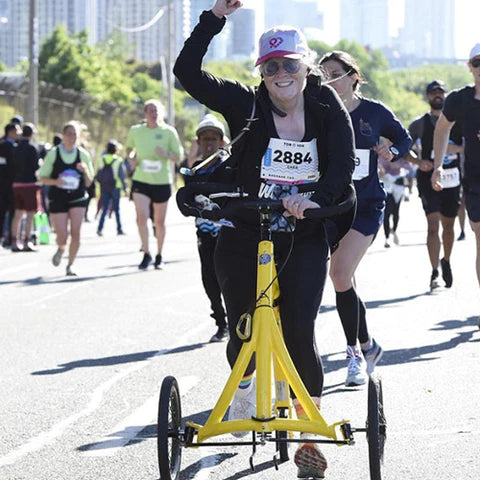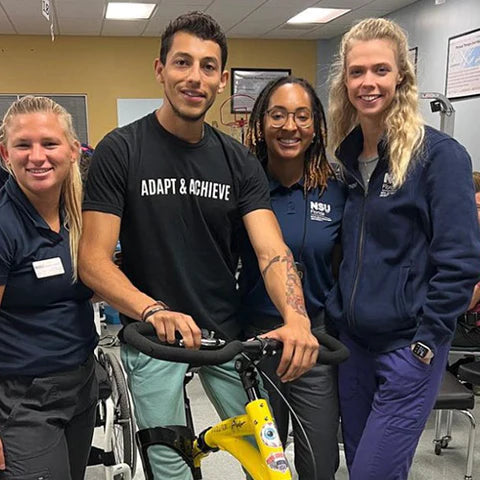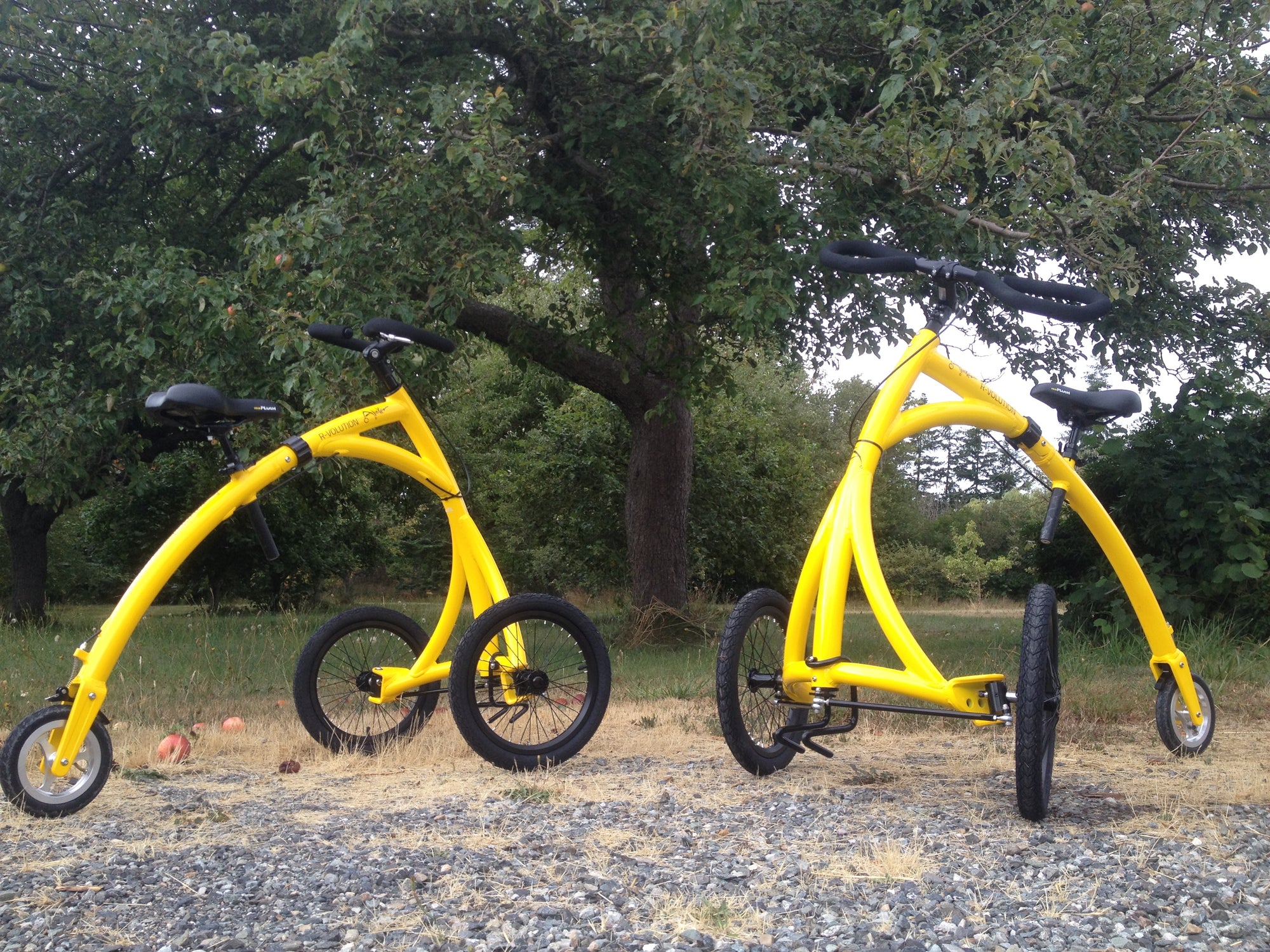By now, many of us are familiar with the original “aha” moment that sparked BE’s imagination and led to the development of the Alinker: On a walk with her mum in the Netherlands, the two of them observed a person using a walker, and BE’s mum said, seemingly out of the blue, “Over my dead body would I ever use one of those.” Somewhat taken aback, BE pressed her mum for an explanation. “With a little bit more conversation I realized that mobility devices emphasize the disability,” BE said. “They create a social divide between people with and without disabilities, and that became quite instantly a justice issue for me.”
It’s one thing to recognize an injustice, but it’s quite another thing to do something about it. But BE recognized a need for a better mobility device: one that people would be comfortable on, excited to use, and that would reduce the stigma and isolation felt by so many people with disabilities. So now we have the Alinker, and we’re able to witness the dramatic changes it has made in so many people’s lives.
But of course, none of that happened overnight. While the “aha” moment story may be familiar, the lesser-known side of things is the years of work undertaken to get to where we are now. “First of all I never thought about becoming an entrepreneur,” BE said. “I don’t think that happens because you have an idea to go and do that, start a business to make money or something. That’s not happening, only much later.” BE had an idea and a vision, but it would be four entire years before they materialized.
In the beginning, BE was “messing around with pieces of wire and some clay and pieces of cardboard.” She would spend hours observing and talking to people about their needs, their frustrations with their current mobility devices, and what they wished for if they were able to design something brand new. “I listened to a lot of people…I saw people hunched over, and I heard people talking about wrist and shoulder pain by either pushing wheelchairs, or pain from crutches.” Learning from her conversations with her mum’s friends and with people on the street, BE had a framework to build from: you have to be eye-level, you have to be safe and stable, and you have to be able to use your legs.
“I designed underneath those needs, which is an overarching frame with a seating assembly so you can sit while you stand,’ BE said. One of the biggest challenges came from the steering mechanism and placement of the wheels. It’s rare to see two wheels in the front. From an engineering perspective, it’s a much bigger challenge. But if the two wheels were in the back, people would kick into them while they were walking, and the tipping line for the device would be in the user’s forward momentum, so it would be much less stable. BE developed a general plan: an overarching frame with a seat, with a small wheel in the back, and two larger wheels in the front to push over obstacles.

“I had an idea,” she said. “I had some little mockup things, like that’s the concept of how it should work.” Armed with the concept, she got in touch with Toby’s Cycle Works, a metal design and fabrication shop in Vancouver, BC. “I came with a wooden prototype into Toby’s shops,” BE recalled. “He was like ‘Oh my god. It’s a woman, with a wooden thing, she wants me to translate that into aluminum, what the fuck.’”
“We developed this really funny relationship,” she said “Between the typical guy engineer thing, ‘make it straight because it’s cheaper,’ and this woman going ‘No it’s gotta be round!” But differences aside, they started prototyping. At this point, BE had a job, and was using her income to finance the development of this new device. After a few different iterations, they landed on what would become the very first version of the Alinker. ‘It was very wonky and it only had a piece of plywood saddle on it,” BE recalled. “I flew to the Netherlands, to my mum and was like ‘This is awesome! You’ve got to try this!’ And she was like ‘No way, I’m not going to get on that thing.’”
So her first potential customer was less than enthusiastic. But on that same trip, a friend of her mum’s, a man in his early 80s, dropped by for a visit and wanted to try the new device. When he got on the early Alinker, BE recalls, “Something happened in his face…he flipped around his cap and he leaned forward and he started running.” As she watched this man - who hadn’t run in 20 years - jog around the plaza, BE realized she was onto something. “With that feedback I was like, holy shit, if that can happen to a guy of 82, then maybe there’s more.”

At this point, after over a year of prototyping, BE felt confident to take the next step. The project she’d been on was coming to an end, and BE had received enough positive feedback on the Alinker that she felt ready to leave work, and go full-time on the Alinker. “After prototype four I thought, I really have something here,” BE recalled. “So I looked for investors. I had no idea what shares were, I had no idea what a company was, I had no idea how you can ask people for money. I had no idea how that worked. So I started studying. I did meet ups. I did a competition for small businesses for entrepreneurs, I dove right into everything.”
BE incorporated the Alinker in August 2012, but it would be another four years before any product actually made it to market. “When you search for something that is not in mobility aid shops, you very often see the coolest things in prototype, or in concepts, but they never make it to market because they can’t make it,” BE explained. “It’s either too expensive because it’s so cool, or they don’t have the money upfront to do the developing process.”
It’s a struggle she understands well. In the immediate years after incorporating, BE was putting all of her time, energy, and savings into developing the Alinker, but positive feedback doesn’t pay the bills. She had to quit her job, and with no income coming in, had to move. “Personally, it was a very hard time,” she recalled. “You pursue an idea that you think might be a great idea from the feedback that you’re getting, at the same time you’re the only one that has the idea, because nobody else sees it yet. So how do you sell an idea that people don’t see yet.”
But an encounter at a meet-up led to an introduction to her first investor, a retiree who spent his time making angel investments. “He said ‘I believe you, and I like you, I’m going to invest in you.’” He also brought three associates to the table, and over a number of years they worked together to develop a plan to bring the Alinker to market. While that was ultimately successful: three financing rounds did bring the Alinker to market, BE is careful to note that it isn’t all roses and butterflies when it comes to bringing a product to market.
She described those initial years as being plagued by uncertainty - a gnawing sense of responsibility to investors without even knowing if the product is going to work, compounded by having to deal with the doubts and discouraging comments of people who don’t entirely trust your vision, or your capacity to pull it off. “The comments that I got from mostly white guys in boardrooms were quite devastating,” BE said. “It was a very bad time. I was on antidepressants, I drank a lot of alcohol, I didn’t even open my windows at all. I will say as a sort of summary, the Alinker nearly killed me, trying to do that in those years. And at the same it kept me alive because I saw what it did to people. So it literally nearly killed me, but it also kept me alive.”
But importantly, the Alinker was now out in the world. BE first launched the Alinker in The Netherlands, through a crowdfunding campaign and a physical tour around the country, giving demonstrations with the bike. Citing Dutch people’s general hesitation to accept new products, she figured, “If they accept a product in the Netherlands, you’ll probably make it anywhere in the world.” And accept it, they did. Although the crowdfunding campaign was only offering pre-sales, Dutch people bought it up. Following that success, they launched a similar campaign in the US and Canada a year later. Again, only pre-sales. And again, people were willing to pay $2000 for even the hope of getting the bike. “I’ve been completely flabbergasted by the demand and the willingness to buy into something that has that hope,” BE said. “That has that vision to it, that clearly wasn’t there, otherwise people wouldn’t just jump to it like that.”
With the success of the crowdfunding campaign under her belt, BE now had a proven demand, if not exactly a sustainable revenue model. But that was enough to get Alinker selected as a SheEO Venture in 2017 (formerly SheEO, now Coralus), which offers a 0% interest-loan to women-led initiatives, and just as importantly, gives you the backing and support of a community of like-minded entrepreneurs and advisors. “I broke down in tears,” BE recalled. “I was like, this is going to change my life. Because then your whole world changes from guys saying ‘It’s a little bit too much risk for us,’ to being with hundreds of women that selected you, that want you to succeed.”

After the SheEO grant, the momentum started to grow. BE was able to access another large grant, and was introduced to Tania Lo, now her CFO and trusted business partner. “Then life started to really improve,” BE said. “The beginning of entrepreneur life, you have to do everything yourself. From finances to marketing to product development, you go through getting an on the job master’s degree in business administration in turbo speed. The moment you can start building a team, you feel that you don’t have to do everything on your own anymore.”
Now the Alinker is gaining ground, and the team is growing each year, and the community developed around the world has been incredible to see. But it’s still not without its setbacks. “It’s still very challenging to have this company,” BE said. “It’s ten years incorporated now, we’re making revenue and we’ve had a few really good years. The pandemic made it a little bit harder, because supply chains fell apart.” But we’re still here, and growing.
“Ideas are cheap and easy,” BE said. “People say to me sometimes ‘Wow, that's a really neat idea.’ And I say, ‘Yeah, ten years ago it was a really neat idea, and then it was ten years of really hard work and nearly doing the impossible to get this idea to a product that has made it to market.’”
Despite considerable obstacles, and the personal toll exacted by trying to make an idea into a reality, BE reflects on how her original vision and her work today are still motivated by the same goal: creating something that gives people hope. “That sounds corny,” BE admitted. “But for me what’s most exciting about the Alinker is that we get to talk about systems, and using the Alinker as a vehicle for change…What always guides me is justice issues. Always. In whatever I do, ultimately it’s always about justice. Being able to use my company as a justice tool, so to speak, makes me super happy.”
